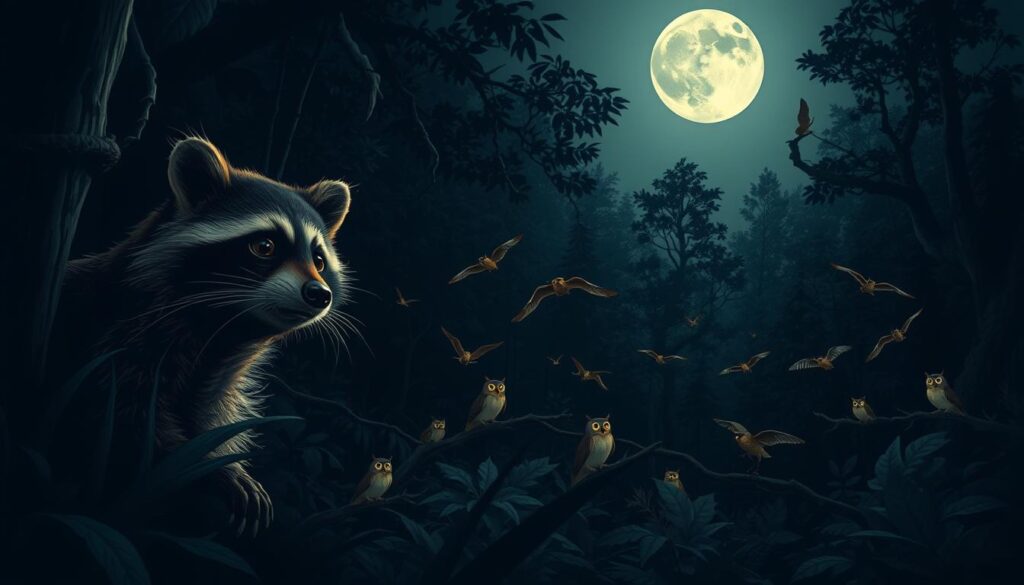Natural soundscapes offer powerful tools for relaxation. Among these, avian melodies echoing through wooded areas stand out as timeless sources of tranquility. Scientific studies reveal these layered acoustic patterns can lower stress hormones by up to 40% within minutes of exposure.
Modern listeners increasingly turn to digital recordings for mental wellness support. High-quality audio collections now capture every rustle and chirp, recreating the sensation of standing beneath ancient trees. These resources prove particularly valuable for city residents lacking regular access to undisturbed ecosystems.
Creative Commons CC0-licensed sound libraries have revolutionized access to therapeutic audio experiences. From meditation apps to office background noise, authentic nature recordings help millions worldwide combat urban stress. The universal appeal spans cultures, with historical records showing similar practices in ancient healing traditions.
Advanced audio technology preserves delicate details often missed by untrained ears. Professional-grade captures reveal hidden dimensions of woodland soundscapes – from distant hoots to nearby wingbeats. This accessibility transforms smartphones into portable gateways for nature immersion.
The Allure of Natural Birdsong
https://www.youtube.com/watch?v=PQ45r6oP9Is
Humanity’s fascination with avian melodies spans millennia, shaping cultures and calming minds. These organic harmonies carry meanings beyond mere biological signals, resonating deeply with human emotions and spiritual traditions.
History of Forest Bird Sounds
Early civilizations treated winged vocalizations as divine messages. Aztec priests interpreted specific calls as weather predictions, while Celtic druids used dawn choruses to mark sacred holidays. Indigenous tribes across continents developed intricate calendars based on seasonal avian patterns.
Explorers like Alexander von Humboldt documented how forest bird communications guided navigation through dense woodlands. Historical manuscripts reveal medieval monks transcribed melodies for meditation purposes, preserving ancient acoustic knowledge.
Cultural Significance in Nature
Many societies view these soundscapes as bridges between physical and metaphysical realms. Hawaiian legends describe ancestral spirits speaking through honeycreepers, while Norse myths portray ravens as Odin’s wisdom-bearers. Traditional Japanese shakuhachi flute music directly mimics bush warbler trills.
Modern conservation efforts draw from this heritage. Organizations protect habitats not just for biodiversity, but to safeguard living sound libraries that inspired art and spirituality for generations. The universal appeal of these acoustic patterns continues influencing music therapy and mindfulness practices today.
Understanding Calming Birds in Forest Sounds
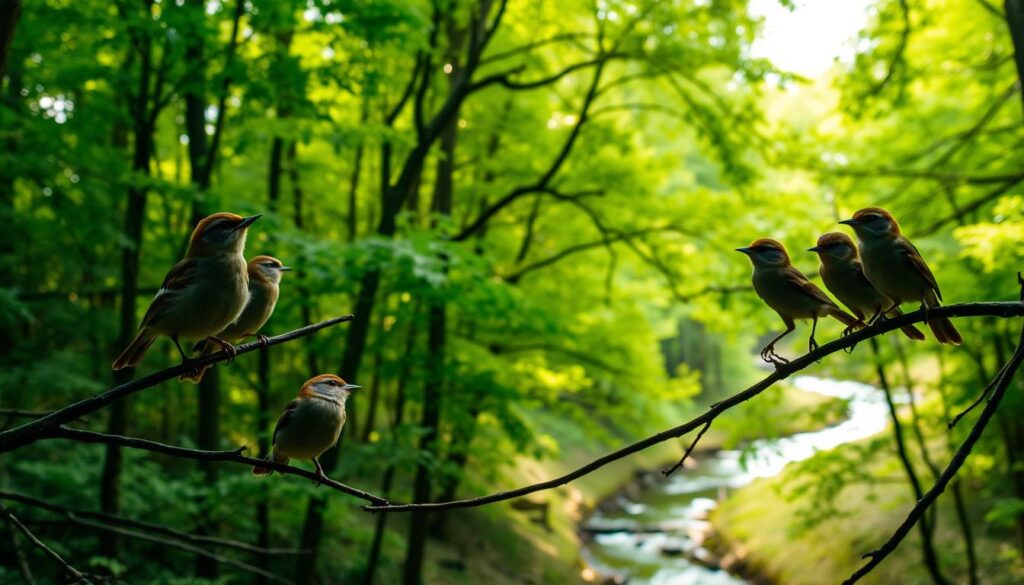
Recent breakthroughs in neuroscience explain why certain acoustic environments promote mental restoration. Researchers discovered that natural auditory patterns interact uniquely with human biology, particularly those found in thriving ecosystems.
Science Behind Soothing Bird Calls
Specific frequency ranges in avian vocalizations trigger measurable relaxation effects. Studies show tones between 2-5 kHz stimulate alpha brain waves associated with calm alertness. This range matches many species’ communication pitches, creating built-in therapeutic properties.
Woodland acoustics naturally disrupt repetitive thought patterns through unpredictable rhythms. Unlike mechanical noises, these organic variations prevent neural adaptation – the brain stays engaged without strain. Neuroimaging confirms simultaneous activation in auditory cortex regions and emotional centers during exposure.
Three-dimensional spatial qualities enhance immersion. Sounds arriving from multiple directions mimic natural environments, triggering deeper relaxation responses than flat recordings. This effect explains why high-quality binaural recordings outperform standard audio formats for stress reduction.
Regular exposure demonstrates cumulative benefits. Clinical trials reveal improved sleep cycles and lowered cortisol levels after consistent use. These findings validate ancient practices of using natural acoustics for healing, now backed by modern science.
Exploring birds in forest sounds: A Healing Perspective
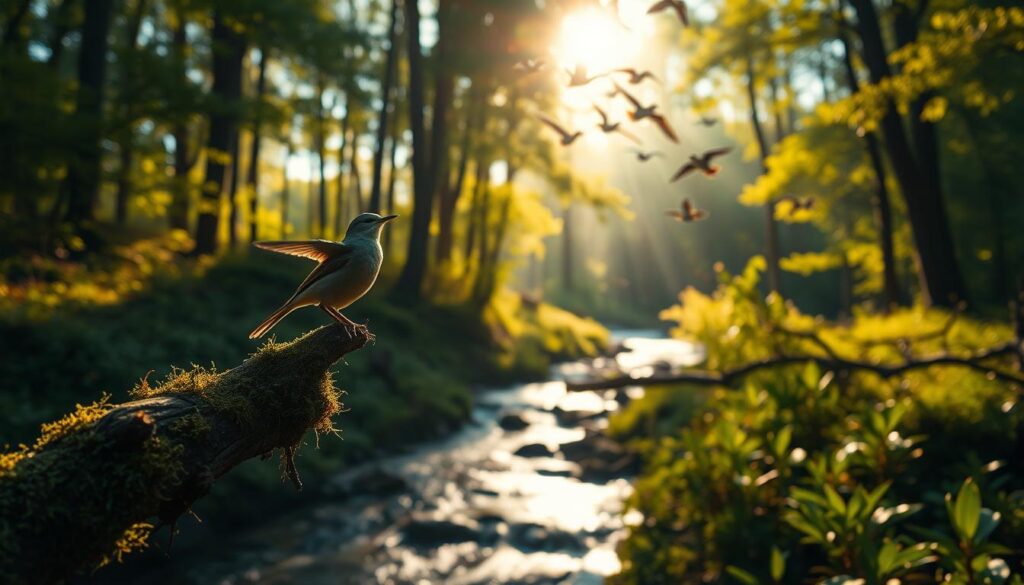
The intersection of ecology and wellness reveals surprising benefits of wild acoustics. Organic harmonies from thriving ecosystems now inform therapeutic practices, blending ancient wisdom with clinical research. This synergy unlocks new approaches to emotional balance and physical well-being.
Emotional Benefits of Birdsong
Melodic patterns in natural environments trigger measurable improvements in mood regulation. Many listeners report instant calmness, linking these auditory cues to memories of safe, peaceful spaces. Evolutionary biologists suggest this response stems from humanity’s deep-rooted connection to biodiverse habitats.
Healthcare settings increasingly use these acoustic profiles to reduce patient anxiety. Burn centers and recovery rooms employ recordings to create calming atmospheres. This approach minimizes reliance on medication for mild stress while maintaining alertness.
Health and Wellness Aspects
Clinical trials demonstrate lowered blood pressure and steadier heart rates during exposure. The effect stems from complex auditory processing that distracts from cyclical worries. Therapists utilize these recordings for PTSD treatment, leveraging their non-threatening qualities.
Long-term benefits include improved sleep patterns and heightened focus. Unlike synthetic noise, organic ambience resists neural habituation – the brain remains engaged without strain. Wellness experts recommend 20-minute daily sessions as part of holistic self-care routines.
Resources for Experiencing Soothing Forest Bird Calls
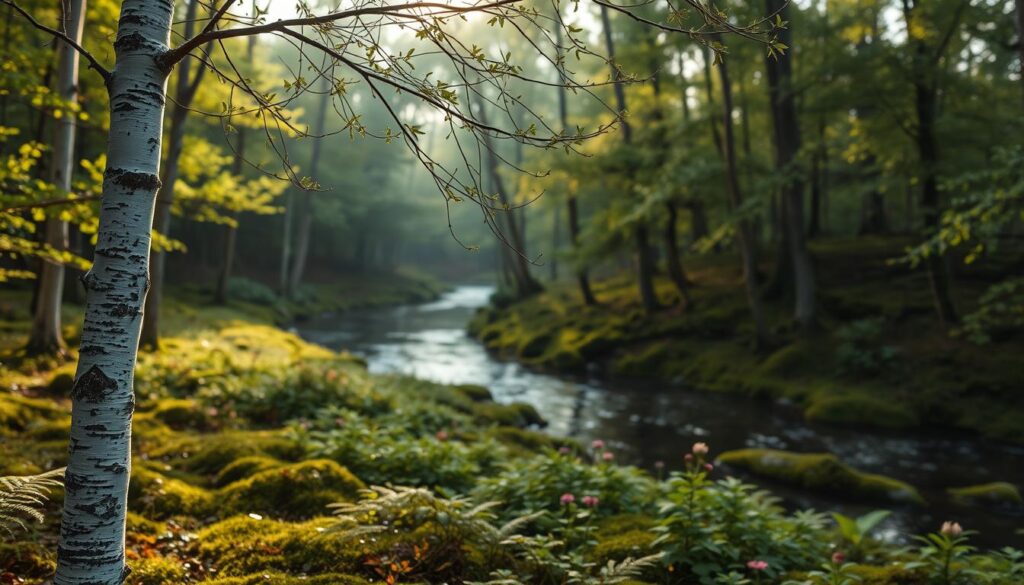
Digital platforms now democratize access to therapeutic acoustic environments. Leading sites provide specialized tools for creating personalized nature immersion experiences, blending convenience with professional-grade quality.
Curated Sound Collections
Expert-vetted libraries prioritize recordings with proven relaxation benefits. Collections often categorize tracks by geographic region, time of day, and specific bird sound types. Detailed metadata includes recording dates, equipment specifications, and behavioral context for each species.
Premium platforms offer multi-layered soundscapes combining distant calls with close-up details. These curated mixes replicate natural acoustic depth while optimizing therapeutic impact. Many services include adjustable volume sliders for balancing different elements.
Downloadable Audio Files
Offline access remains crucial for wilderness therapy applications. High-resolution downloads preserve spatial audio qualities lost in compressed streams. Platforms like Mixkit provide royalty-free files suitable for meditation apps, sleep aids, and creative projects.
Mobile applications extend functionality with timer settings and background mixing options. Users can combine dawn choruses with evening insect rhythms, creating seamless day-night cycles. Free tiers ensure accessibility while premium subscriptions offer studio-grade recordings.
The Science of Bird Communication in Forests
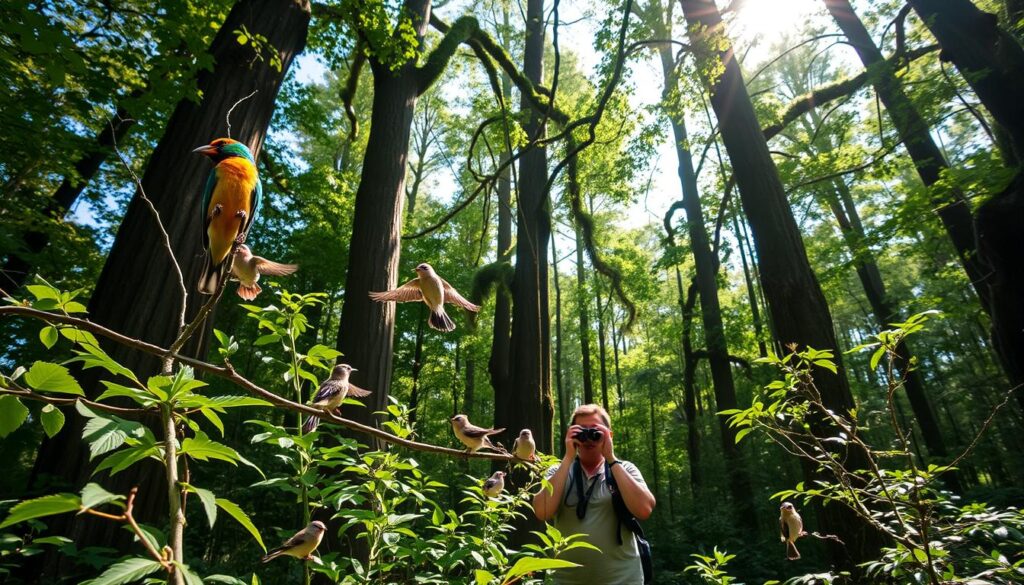
Avian communication systems in wooded ecosystems demonstrate remarkable acoustic engineering. These complex interactions evolved to overcome challenges like dense foliage and competing noises. Specialized vocalizations serve essential survival functions while shaping entire sound environments.
Acoustic Patterns and Bird Behavior
Woodland species developed distinct calling strategies for different purposes. Territorial announcements often use lower frequencies that penetrate vegetation. Mating signals typically feature intricate pitch variations to showcase vitality.
The Varied Thrush exemplifies this adaptation with metallic whistles that cut through damp Pacific Northwest air. Its sustained single-note call travels farther than multi-tone vocalizations in dense habitats. Researchers note these unique patterns disappear when the species ventures into urban areas.
Environmental factors constantly influence communication tactics. Canopy density determines sound reflection patterns, while wind conditions affect transmission ranges. Some species adjust their singing times to avoid competing with noisier neighbors.
Scientists use bioacoustic monitoring to assess habitat quality through vocal activity levels. Healthy ecosystems maintain diverse daily sound patterns, while degraded areas show simplified rhythms. This data helps track climate change impacts and conservation success.
Unique Characteristics of Forest Bird Songs
Woodland vocalizations form nature’s most intricate acoustic fingerprints. Each species crafts signature patterns shaped by habitat needs and evolutionary pressures. Trail enthusiasts report recognizing specific calls along routes like Anthill Trail, where the Varied Thrush’s metallic whistle cuts through misty air.
Identifying Distinct Bird Species
Vocal distinctions allow experts to map biodiversity without visual cues. A forest bird might use rapid trills for territory claims while employing softer chirps during nesting. These variations create layered soundscapes where multiple species interact like orchestra sections.
Seasonal changes dramatically alter acoustic profiles. Spring brings complex mating sequences, while autumn features shorter contact calls. Urban-dwelling counterparts often lose these nuances, adapting simpler tones to compete with city noise.
Advanced recording tools uncover hidden details in bird sound patterns. Slowed-down audio reveals micro-pauses and pitch shifts imperceptible to human ears. This technology helps conservationists track population health through vocal activity levels.
Geographic regions develop recognizable auditory identities. Pacific Northwest forest choruses differ markedly from Appalachian Mountain repertoires. Hikers often associate specific trails with unique combinations, creating sound-based memories of their journeys.
Field Observations and Personal Experiences with Bird Calls
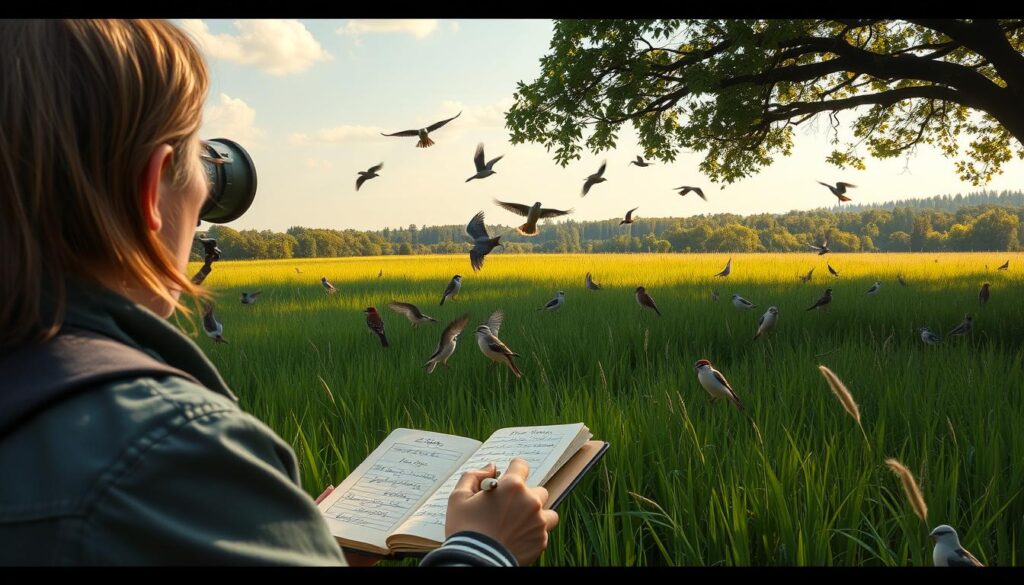
Wilderness explorers often describe unexpected encounters with vocal wildlife as transformative moments. These acoustic surprises create vivid memories, shaping how people perceive natural spaces. One hiker’s account of a piercing single-note call in Olympic National Park illustrates this phenomenon perfectly.
User Testimonials
Trail journals overflow with stories of mysterious trills echoing through misty valleys. “I spent hours tracking a flute-like melody,” recalls Appalachian Trail veteran Mara Simmons. “Discovering it came from a hermit thrush felt like solving a musical riddle.” Many report developing personal nicknames for unfamiliar vocalizations, like “the elevator ding bird” for the Varied Thrush’s metallic tone.
Seasonal changes add layers to these experiences. Winter hikers in Colorado share tales of hearing mountain-dwelling species at lower elevations. These temporal shifts create opportunities for casual observers to encounter rare vocal patterns normally hidden in remote habitats.
Expert Comments
Ornithologists emphasize the value of these personal accounts. “Public observations help track migration timeframes and habitat use,” explains Dr. Ellen Park of Cornell Lab. Her team cross-references amateur reports with scientific data to monitor population trends.
Acoustic ecologists note that memorable calls often share specific traits. Repeated phrases cut through background noise, while unique frequencies trigger human pattern recognition. This combination explains why certain bird vocalizations become signature sounds of particular trails or regions.
Community platforms transform individual experiences into collective knowledge. Shared audio clips and descriptive accounts help newcomers identify species while contributing to conservation databases. This synergy between personal discovery and scientific study enriches our understanding of avian communication.
Interpreting the Ambient Sounds of Forests
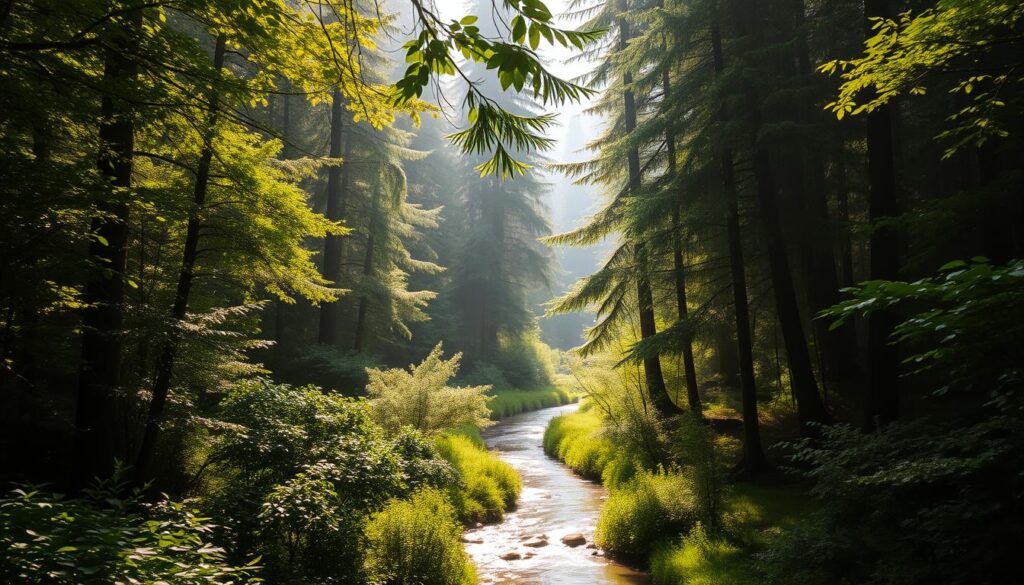
Layered acoustic textures form nature’s original symphony. A thriving woodland mixes rustling foliage, distant trills, and subtle creaks into seamless harmony. These elements interact dynamically, creating depth that surpasses individual components.
Decoding these auditory patterns reveals ecological relationships. Leaves crunching underfoot signal dry conditions, while dripping water hints at recent rainfall. Professionals analyze pitch variations to gauge canopy density and soil moisture levels.
Daylight phases reshape acoustic profiles dramatically. Dawn delivers crisp, overlapping melodies as creatures establish territories. Midday brings softer exchanges beneath rustling branches. Dusk introduces deeper tones as nocturnal species awaken.
Weather acts as both conductor and instrument. Gentle breezes create whispering treetop rhythms, while storms produce percussive leaf impacts. Temperature shifts alter sound transmission – crisp winter air carries calls farther than humid summer evenings.
Therapeutic benefits emerge from this organic unpredictability. Unlike repetitive urban noise, natural ambience maintains gentle variation that distracts anxious thoughts. Recordings preserving these nuances use specialized mics to capture faint crackles and distant echoes.
Seasonal transformations rewrite the sonic landscape entirely. Spring births energetic mating sequences, while autumn introduces migratory farewells. Each phase offers distinct auditory signatures that chronicle ecological cycles.
Bird Sound Effects and Their Digital Applications
Digital innovation transforms avian vocalizations into versatile creative tools. Platforms like Mixkit provide studio-grade recordings that fuel projects across industries. These resources bridge nature and technology, offering authentic acoustic elements for modern needs.
Entertainment sectors leverage these assets extensively. Film editors layer bird sound effects to build believable outdoor scenes, while game designers create immersive virtual ecosystems. Music producers weave these organic textures into tracks, adding depth to ambient compositions.
The wellness industry harnesses these digital files for therapeutic purposes. Meditation apps combine species-specific calls with calming music to reduce anxiety. Clinics use curated playlists to mask stressful noises in treatment rooms, enhancing patient comfort.
Educational tools benefit from realistic audio integration. Virtual field trips employ spatial sound to teach wildlife behavior. Language apps use territorial calls as memory aids for species identification exercises.
Accessibility remains a key advantage. Free libraries democratize professional-grade resources, empowering indie creators and global nonprofits alike. Urban planners even use these recordings to design public spaces with nature-inspired auditory features.
As demand grows, quality standards evolve. Advanced filtering techniques remove background interference while preserving acoustic richness. This precision ensures digital files maintain their calming properties across applications – from VR headsets to hospital speaker systems.
Historical Perspectives on Birdsong in the Wilderness
The study of wilderness acoustics carries echoes from past civilizations. Early naturalists documented avian vocalizations long before modern recording tools existed. Their handwritten journals reveal meticulous observations about seasonal patterns and territorial behaviors in wooded areas.
Timeline of Acoustic Discoveries
Nineteenth-century explorers revolutionized our understanding through detailed field notes. John James Audubon’s sketches often included musical notations of bird calls, blending art with early bioacoustic research. These records helped later scientists track habitat changes over time.
Breakthroughs came with Thomas Edison’s phonograph in 1877. For the first time, researchers could preserve and analyze fleeting vocalizations. Early wax cylinder recordings captured species now extinct, creating invaluable archives for modern conservationists.
Indigenous communities contributed profoundly through oral traditions. Many tribes used specific calls as environmental indicators long before Western science recognized their significance. This knowledge now informs habitat protection strategies worldwide.
Urban expansion created stark contrasts in acoustic landscapes. Industrial-era documents show dwindling reports of forest bird activity near cities. Modern comparisons reveal how noise pollution continues reshaping avian communication patterns.
Impact of Seasonal Changes on Forest Bird Activity
Nature’s symphony transforms with the turning seasons, reshaping auditory landscapes in woodland habitats. These shifts reveal intricate connections between weather patterns and wildlife behavior. Researchers track how temperature and daylight hours influence communication strategies among tree-dwelling species.
Bird Activity Patterns
Migratory rhythms dictate when forest bird populations occupy specific elevations. The Varied Thrush exemplifies this pattern, moving to lower valleys as snow blankets mountain ranges. Spring arrivals trigger territorial displays, with males performing elaborate aerial dances to claim nesting sites.
Winter months simplify social structures. Flocking behavior increases survival odds, creating concentrated pockets of activity. Reduced vocalizations during cold spells conserve energy while maintaining essential group coordination.
Seasonal Variations in Calls
Breeding seasons unleash cascades of complex bird sound arrangements. Multilayered songs serve dual purposes – attracting mates while deterring rivals. Scientists note increased pitch variation and repetition during these competitive periods.
Autumn introduces shorter contact calls that facilitate group movements. Advanced recording devices capture subtle differences between migratory announcements and routine chatter. These distinctions help conservationists monitor population health across changing forest conditions.



